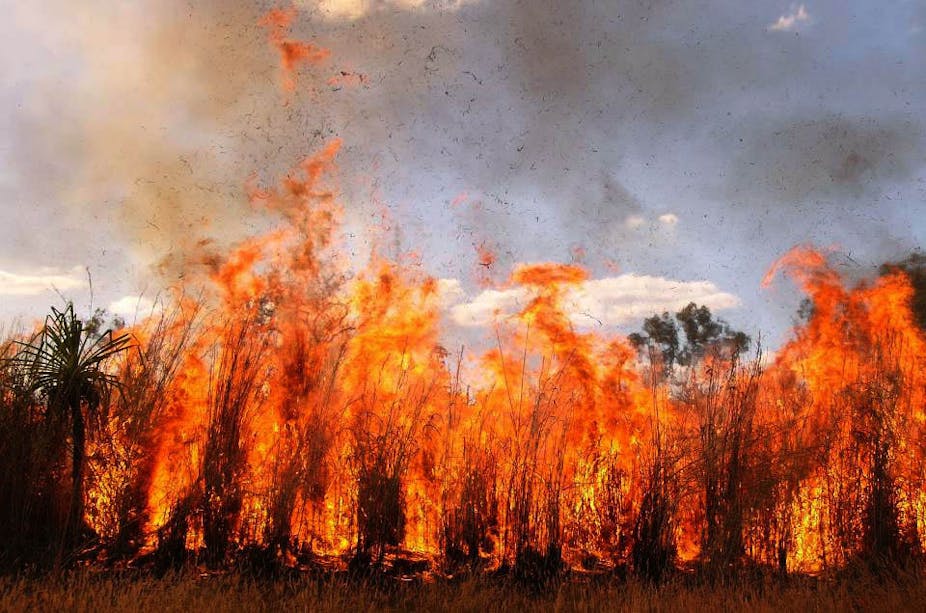Stretching across the north from Broome to Townsville, Australia’s tropical savannas are the largest, least-degraded savannas on Earth.
While fire management, pastoralism, mining, and the decline of native mammals are among the major threats facing our savannas, it is a simple grass, gamba grass, that may pose the greatest long-term threat to their future integrity.
Out of the paddock
Gamba grass is a robust perennial grass from Africa that was introduced to Australia as a pasture grass. In 1986, after much trial and error, the Northern Territory Department of Primary Industries developed a cultivar that was, in the words of their own register notes, “easily established”, “highly productive”, “drought resistant”, “adapted to seasonally wet tropics”, and “adapted to a wide range of soils”. These characteristics, desirable to DPI at the time, also made gamba grass an aggressive weed.
The first wide-spread trials of gamba grass were in the late 1980s and 1990s in several paddocks in the Top End and in the Cape York Peninsula. Even at the time of introduction there were significant concerns about gamba grass. Despite assurances that it could be safely contained within heavily grazed paddocks it quickly escaped, established and spread into native savanna.
The rate of spread of gamba grass is among the highest of any invasive plant in the world. Today it has spread widely in Cape York and there are reports of outbreaks in the Kimberley and Arnhem Land, but the most significant infestations are within 200 km of Darwin.
Over one third of Litchfield National Park, a major tourist draw 100km from Darwin, is now infested with gamba grass. Equally worrying are significant infestations along the western and southern boundary of Kakadu National Park, which will increasingly occupy park rangers as they try to keep it at bay.
Fire hazard
Gamba grass grows up to four metres tall and can produce up to five times the biomass of native Australian grasses. In the highly flammable savanna environment of Australia the combination of vertical height and high fuel loads has proved catastrophic. Quite simply, our savanna trees have evolved magnificently to cope with fire, but only if fires are frequent, low intensity and low to the ground.
Research has found that where gamba grass comprises the bulk of ground cover, the tree cover and the habitat those trees provide to our threatened native marsupials can decline by 50% in less than five years due to fire mortality.
The extensive spread of gamba grass in the Batchelor region, approximately 70km south of Darwin, has forced a re-evaluation of the fire danger index to account for higher fuel loads caused by gamba grass.
Responding to gamba grass fires has required investment in new equipment, including the helicopters, fire trucks and personal protective equipment more associated with catastrophic bushfires in southern Australia than with savanna fires up north. The associated costs of such equipment, plus the need to be on call as the number of high fire risk days increase are estimated to cost the rural fire services around Batchelor an additional $1 million per year.
Through intense fires, gamba grass also reduces the carbon stocks locked away in our vast savannas. Gamba grass is a net greenhouse gas emitter and poses a significant threat to the carbon abatement schemes that are being developed to bring employment opportunities and better fire management to the north.
A weed of national significance
With such a clear impact on the environment, personal safety, and the public budget, gamba grass is a clear candidate for status as a weed of national significance (WoNS), a federal designation which to date has come with a national strategic plan plus the money and a national coordinator role to implement the plan.
Although gamba grass was not added to the initial WoNS list in 1999, it was added to a revised list in 2012. Perversely, however, this status has been granted at a time when national discourse has shifted to austerity.
While an action plan for gamba grass exists, the Federal Government will not commit to a predefined allocation of funds for WoNS coordination so that it now appears that development and implementation of a national strategic plan will be up to the chances of successfully accessing competitive funds.
This is a false economy, as early investment in weed management saves money down the track. This goes doubly so for a species such as gamba grass, which demonstrably poses a serious risk to quality of life, economic opportunity and to our largest and most pristine biome.
Fortunately, gamba grass is only a grass. It responds well to chemical treatment (there is no need to import elephants or rhinoceroses to take care of the problem). What is lacking is the strategic vision, awareness and public will to tackle the problem now, before it gets much, much worse.

